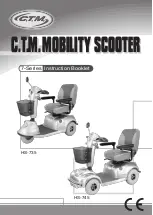
CAUTION!
Risk of tipping over
–
Only ever drive downhill at a maximum of 2/3 of the
top speed. Avoid sudden changes of direction or
abrupt braking when driving on slopes.
–
Always return the backrest of your seat or the seat tilt
(if adjustable seat tilt is available) to an upright position
before ascending slopes. We recommend that you
position the seat backrest or the seat tilt slightly to
the rear before descending slopes.
–
Always lower the lifter (if fitted) to its lowest position
before ascending or descending a slope.
–
Never attempt to ascend or descend a slope on
slippery surfaces or where there is a risk of skidding
(such as wet pavement, ice etc).
–
Avoid trying to get out of the vehicle on an incline
or a gradient.
–
Always drive straight in the direction the road or path
you are on goes, rather than attempting to zigzag.
–
Never attempt to turn around on an incline or a slope.
CAUTION!
Braking distance is much longer on a downhill
slope than on even terrain
–
Never drive down a slope that exceeds the maximum
safe slope (refer to 13 Technical data, page 57).
7.9
Pushing the mobility device in freewheel
mode
The motors of the mobility device are equipped with automatic
brakes, preventing that the mobility device starts rolling out of
control when the remote is switched off. When pushing the mobility
device manually whilst freewheeling, the magnetic brakes must be
disengaged.
Pushing the mobility device by hand may require more
physical force than expected (more than 100 N). The
necessary force nevertheless complies with the requirements
of ISO 7176-14:2008.
7.9.1
Disengaging/Engaging Motor Lock Levers
WARNING!
–
DO NOT engage or disengage motor locks until the
power is in the OFF position.
CAUTION!
–
Ensure both motor release levers are fully engaged
before driving the personal transporter.
1580058-B
41
















































